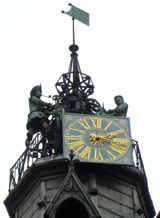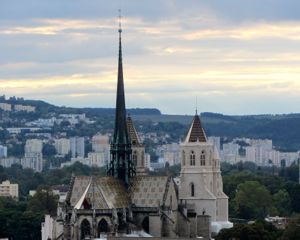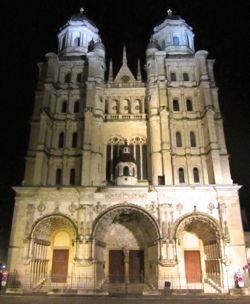 |
Churches in Dijon, France | |
| Dijon has many lovely churches and former churches to visit. | ||
|
|
|
Like many French cities, Dijon boasts a large number of historic churches. Many of these are included on the Owl's Trail Walking Tour, and they're all in easy walking distance of the center of town, the Place de la Libération (map). The Église Notre-Dame, located just behind the Palais des Ducs and the Tourist Office (map), dates from the 13th century. It's famous for several things: the carved owl (on a pillar on the left side as you face the church) which is a symbol of good luck; and the many "false gargoyles" on the facade. Legend has it that a moneylender who had come to Dijon to be married was crushed when a gargoyle fell. His colleagues had them removed, and in the late 1800s sculptors made the "false gargoyles" that are visible today (there are a few original ones on the sides).
The third distinction of the Église Notre-Dame is the Jacquemart clock on top of the church. The Duke Phillip The Bold took the clock as a spoil of war and brought it to Dijon in 1383. Jacquemart refers to the mechanized figure that rings the bell by pounding it with a hammer or other tool. Another Dijon legend says that the citizens thought the Jacquemart must be lonely, so in the 17th century they gave him a wife, in the 18th century a son, and the 19th century a daughter! Just up the street from the Place de la Libération is the Église St-Michel, a Flamboyant Gothic church dating from the 16th century (although the upper parts were added considerably later and were inspired by the Renaissance). St-Michel has three doors, and the one on the right is the oldest, bearing a date of 1537. Nearby is the former Église St-Etienne, now serving as a cultural center. It includes the municipal library and a small museum focused on Dijon sculptor François Rude. And don't miss the small Chapelle des Élus, which is in the Palais des Ducs de Bourgogne and accessed via the Tourist Information Office. This small chapel was built by Louis XV in the 1700s and is known for its lovely decoration. Dijon also has a Cathedral, St-Bénigne, located not far from the Place D'Arcy (map). It was named for the first apostle of Burgundy, whose relics are in the crypte. Although the cathedral's style is Burgundy Gothic, the crypte is Romanesque, with a large rotunda. The cathedral's 93 meter (305 foot) spire is the tallest in Dijon. It's also known for its lovely tile roof and its buttresses. The former abbey, just next to the cathedral, is now home to the Archaeological Museum. Just down the street from the Cathédrale St-Bénigne is the old Église St-Philibert. Deconsecrated at the time of the French Revolution, it is in precarious shape and cannot be visited. You might want to admire the exterior, an excellent example of Romanesque Burgundian architecture from the 12th century, with a Gothic steeple added in the 16th century. Another former church, St-Jean, is just a little farther down the road, at the Place Bossuet (map). Jacques-Bénigne Bossuet, a theologian and Bishop, was born in Dijon in 1627, in a house near St-Jean. In 1980 St-Jean was converted to a theater and today is the home of the Théatre Dijon Bourgogne.
|
|
Above, The Cathédrale St-Bénigne, seen from the top of the Tour Philippe Le Bon.
|


